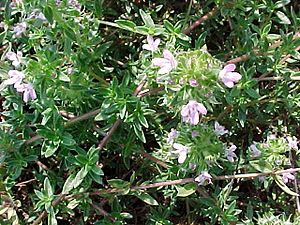Thymus herba-barona facts for kids
Quick facts for kids Thymus herba-barona |
|
|---|---|
 |
|
| Scientific classification | |
| Genus: |
Thymus (plant)
|
| Species: |
herba-barona
|
Thymus herba-barona is a type of thyme plant. It grows naturally on the islands of Corsica, Sardinia, and Majorca in the Mediterranean Sea. People often call it caraway thyme because it smells a lot like caraway seeds. You can even use it in cooking instead of caraway! It's also a great evergreen plant to grow in gardens as a ground cover.
There are two main types, or subspecies, of caraway thyme:
- Thymus herba-barona subsp. herba-barona: Found in Corsica and Sardinia.
- Thymus herba-barona subsp. bivalens: Found in Majorca, Spain.
Contents
What is Caraway Thyme?
Caraway thyme is a plant that grows close to the ground. It has a woody base and can reach about 10 to 25 centimeters (4 to 10 inches) tall. It spreads out to about 30 centimeters (12 inches) wide.
Leaves and Flowers
The leaves are dark, shiny green and a bit hairy. They are about 4 to 10 millimeters (0.16 to 0.39 inches) long. These leaves have that strong caraway smell.
The flowers are pink and have four petals. They also have a noticeable lower lip. These pretty flowers appear in late spring and early summer. They are very popular with bees and butterflies!
Growing and Using Caraway Thyme
Caraway thyme likes to grow in regular soil with some water and lots of sunshine. It was once a favorite seasoning in England for big cuts of beef. This is how it got its scientific name, which includes "barona." Today, people grow caraway thyme in gardens all over the world.
How to Grow It
It's a bit tricky to grow caraway thyme from seeds. Because of this, most people buy small plants that are already 5 to 10 centimeters (2 to 4 inches) tall in little pots.
Other Uses
Caraway thyme contains a special oil. This oil can be used as an antiseptic (to kill germs), a deodorant (to make things smell fresh), and a disinfectant (to clean surfaces). It's also used to make perfumes and as a mouthwash.
In the past, people used it as a traditional medicine. Scientists have studied the oil from caraway thyme. They found that it works well against certain types of gram-positive bacteria and fungi. It works similarly to a well-known antiseptic called chlorhexidine gluconate.

